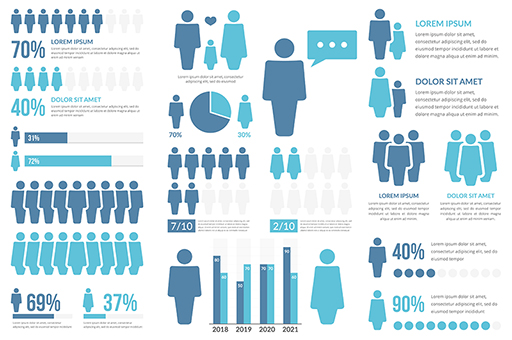2.2 Metrics and data collection
Measuring diversity and inclusion can be challenging, but being able to identify where it thrives within your organisation and where it needs more work, whether that is across particular employee groups or certain sections of your business, is vital.
Measuring diversity
It is important to understand your workforce composition. You can do that by encouraging employees to share their personal data, explaining why it is important and what you are going to do with it, and by analysing the diversity data you hold.
PwC and the Investment Association’s Diversity Data Guide (2021), provides a list of data that is typically collected in the UK alongside a list of data that is increasingly being collected:
| Typically collected | Increasingly collected |
|---|---|
| Sex | Socioeconomic status/background (‘social mobility’) |
| Age | Faith |
| Ethnicity | Caring responsibilities |
| Sexual orientation | Further detail in relation to disability |
| Gender identity | Neurodiversity |
| Disability |
This guide provides useful advice about data gathering and analysis, and is followed up by an updated version in 2024 (Bennett et al, 2024) which has a focus on improving the quality of your data and using it strategically.
Once you have this basic data there are other things you can measure, for example are some groups more likely to get shortlisted and appointed, obtain promotion, have opportunities for development? These all tell part of the story and help to clarify where your organisation is at a given time.
Measuring inclusion
Inclusion focuses on the employee experience in the workplace and so can be more difficult to measure. The data you must collect is more orientated towards feelings and perceptions, such as how an employee feels about your organisation’s practices, how included they feel in decision making, how they interact with their line managers/peers etc. You need to gauge whether your employees feel they are heard, valued and have equal opportunity to fulfil their potential.
After conducting a survey of approximately 10,000 employees around the world, research and advisory company Gartner has distilled its findings into seven statements that best represent different elements of inclusion (Romansky et al, 2021). These form the basis of their Gartner Inclusion Index.
The greater the degree to which employees agree with these statements, the more inclusive your organisation:
- Fair treatment: Employees at my organisation who help the organisation achieve its strategic objectives are rewarded and recognised fairly.
- Integrating differences: Employees at my organisation respect and value each other’s opinions.
- Decision making: Members of my team fairly consider ideas and suggestions offered by other team members.
- Psychological safety: I feel welcome to express my true feelings at work.
- Trust: Communication we receive from the organisation is honest and open.
- Belonging: People in my organisation care about me.
- Diversity: Managers at my organisation are as diverse as the broader workforce.
Romansky recommends that ‘using a framework like the Gartner Inclusion Index, can provide some hugely helpful insights and serve as a benchmark across time’. But there are potential pitfalls, including:
- Taking too much time to get from analysis to an action plan
- Assuming that survey results will be sufficient to fully guide the action planning process
- Neglecting to share the actions taken as a result of employee surveys.
Ellsworth et al (2021) present a different model, where they divide overall inclusion into personal experience and enterprise perception.
| Overall inclusion | |
|---|---|
| Personal experience | Enterprise perception |
| Authenticity – individuals feel encouraged to be themselves and speak up at work | Acceptance – employees value and embrace diversity |
| Belonging – individuals feel connected to others at work | Camaraderie – employees have strong bonds and work together toward shared goals |
| Meaningful work – individuals feel their work is personally meaningful and valued, and contributes to the company’s success | Fairness – employees receive equitable treatment and have a fair chance to succeed |
They explain that ‘comparing these two elements can highlight discrepancies that may occur between them.’ For example, an employee may perceive that an organisation (enterprise) has the systems in place to facilitate inclusion, e.g. fair and unbiased performance evaluations, while simultaneously feeling that they are not personally included, e.g. not having a voice in team decisions.

